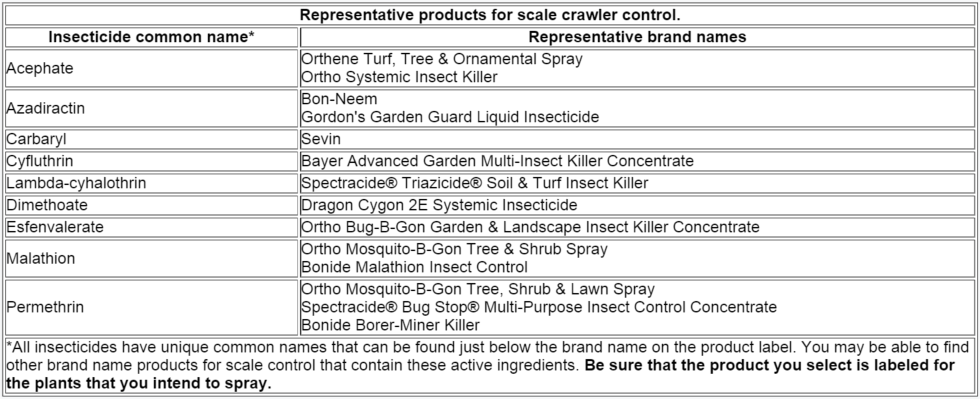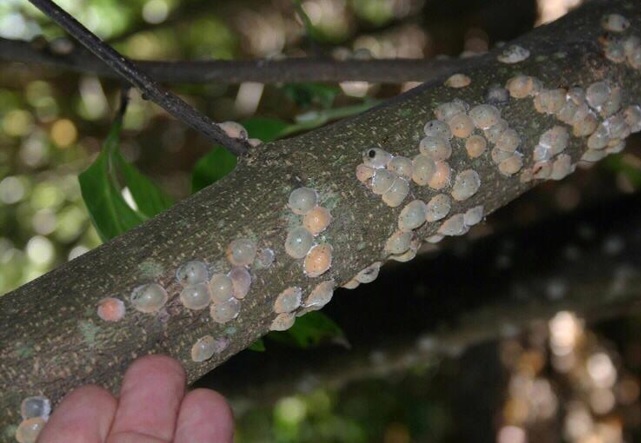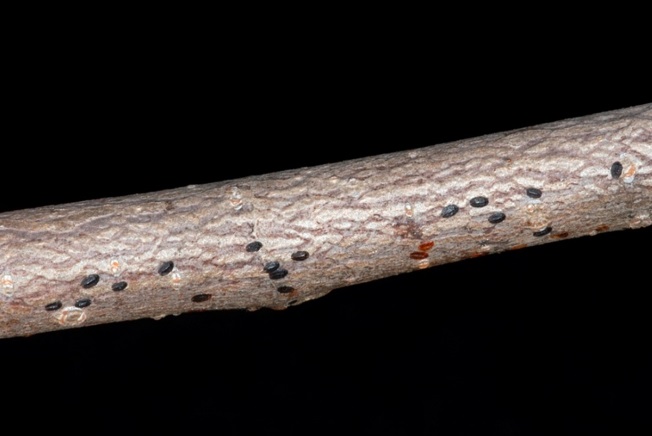Magnolia Scale
ENTFACT-431: Magnolia Scale | Download PDF
By Jonathan L. Larson, Extension entomologist and Lee Townsend, Extension Specialist Emeritus
University of Kentucky College of Agriculture
Magnolia Scale Fast Facts
- Magnolia scale is the largest species of soft scale that we encounter. The adult females are ½ inch in diameter.
- They commonly attack star, saucer, and lily magnolias.
- The most common symptom is the appearance of large quantities of honeydew, a sticky fecal material that will accumulate on the plant and attract sooty mold.
- Management can depend on crawler control using contact insecticides or organic options like horticultural oil or insecticidal soap or can rely on systemic treatments of imidacloprid or dinotefuran.
Mature female magnolia scales are quite large and noticeable. These puffy soft scale pests can lead to dieback in the tree and the accumulation of honeydew on the plant and nearby (Photo by Bill Fountain, University of Kentucky Department of Horticulture).
Potential Hosts
As the name implies, magnolia scale is a pest of magnolia trees. Magnolia varieties that may be more heavily impacted than others include saucer, star, and lily magnolias.
Symptoms and Pest Description
Scale insects are “sucking pests”, meaning they use a needle like mouth to siphon fluids from plants. Magnolia scales are part of the “soft scale” group, meaning that they do not produce a waxy shield that covers their body. Soft scales are known for their ability to produce large amounts of honeydew. Since these insects are processing/feeding from sugary sap all day, they also defecate out this sugary water-like substance. Accumulations of honeydew are shiny and sticky and may also recruit black sooty mold fungus which feeds on honeydew and may cover branches and the trunk. Honeydew may also recruit other insects to visit the scales. Ants, wasps, and other will consume the sugary feces and may be more noticeable than the scale insects themselves. When infestations get large, there can be branch dieback, canopy thinning, and possible death of the tree.
The magnolia scale is the largest soft scale we encounter, with mature females about ½ inch in diameter. They will look like large pink-orange or brown bumps and can have a white waxy powder on their body as well. Males look quite different as they mature. They will become small, pink gnat like insects that can fly and mate with females.
Life Cycle in Kentucky
Magnolia scales overwinter as dark colored nymphs on the relatively new growth of their host tree. In the spring, these immature scales will resume feeding and continue to grow and mature. Males will complete their development into their adult pink gnat like forms. Males will mate with females in the early summer and then perish. Females will continue to feed and develop into the noticeable, large scales with a purple-brown coloration in June and a yellow brown color by July. The female’s eggs hatch inside of her and immature crawlers will emerge in July and August. These crawlers will find a spot to feed and then overwinter to begin the process anew the next year.
Magnolia scales overwinter as crawlers on the newer growth of the tree. In the spring they will resume feeding and complete their development (photo by Jim Kalisch, University of Nebraska-Lincoln).
Management
Scales tend to thrive on stressed plants. Following a recommended fertility program and watering regime will promote plant health. However, over-fertilization favors scale buildup. If practical, improve plant sites to reduce stress and promote growth. You can prune out small infestations to try and eliminate the issue or prune out sections of a large scale problem in order to make chemical control more feasible.
There are two options when considering management of scales, doing a systemic treatment or treating the crawlers directly. Whichever you choose, management may take repeated applications over a couple of growing seasons.
Treating with Systemic Insecticides
When dealing with soft scale species such as the magnolia scale, you can use a systemic treatment of imidacloprid (Bayer Tree & Shrub is one possible trade name) or dinotefuran (Orthro Tree & Shrub is one possible trade name). A systemic insecticide helps to give you control without reliance on broadcast sprays on the plant. This helps keep insecticide residues contained within the plant you wish to protect and helps to ensure the product will affect the pests you are targeting. Timing is important when choosing to use a systemic product though. An application of imidacloprid in May, after flower petals have fallen from the tree, will provide protection. For dinotefuran, applications can be made in August to provide control the next year.
Treating Crawlers Directly
Crawlers are the most susceptible to control stage of a scale insect’s life. To treat the crawlers, you should be monitoring for their emergence. You can visually check in late July through August for magnolia scale crawlers. Alternatively, you can place pieces of black electrical tape (sticky side out) or double-sided tape near scale populations and monitor the tape for the crawlers and treat following the initial find.
Horticultural oils kill crawlers by suffocation or after penetrating over-wintering stages of the insect. Consequently, they may not be effective where several layers of scale coverings have accumulated. Insecticidal soaps are long chain fatty acids that kill susceptible insects through direct contact. Like horticultural oils, they require thorough coverage. Soaps leave no residue so repeated applications may be needed for some pests. These products may burn the foliage of sensitive plants, such as Japanese maple, so check the label for information about the plant species that you intend to treat.
A variety of natural and synthetic insecticides are labeled for use as sprays to control scale crawlers on landscape trees and shrubs. While the residual life of these products is generally longer than oils and soaps, timing, coverage, and precautions on damage to some plant species are very similar to those for oils and soaps.
Below are some options for scale insect crawler control.

Evaluating Control
The success or failure of control efforts may not be readily apparent but here are some things to check.
- Live scales should produce a liquid when mashed, dead scales will be dry and not "bleed" when crushed.
New foliage should have a healthier appearance once the scale burden has been removed. Buds should break a little earlier than when the plant was infested and expanded leaves should have normal color and turgor.
Revised: 2/21
CAUTION! Pesticide recommendations in this publication are registered for use in Kentucky, USA ONLY! The use of some products may not be legal in your state or country. Please check with your local county agent or regulatory official before using any pesticide mentioned in this publication.
Of course, ALWAYS READ AND FOLLOW LABEL DIRECTIONS FOR SAFE USE OF ANY PESTICIDE!
Images: University of Kentucky


